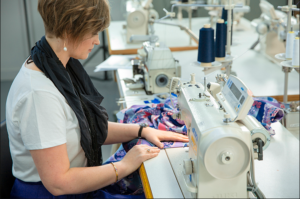 The fashion industry has transitioned to become extremely technology and digitally focused. Many retailers have now progressed through the first stage of e-commerce retailing by creating visually appealing online stores, integrating payment gateways and offering extremely efficient delivery logistics.
The fashion industry has transitioned to become extremely technology and digitally focused. Many retailers have now progressed through the first stage of e-commerce retailing by creating visually appealing online stores, integrating payment gateways and offering extremely efficient delivery logistics.
When it comes to the new world of fashion technology, it seems like nothing is outside the realms of possibility. With new designs emerging regularly, from crystal dresses controlled by remote control or dresses that change colours, it seems people are looking to achieve a high-tech fashion future. Technology is having a massive influence on all elements of the fashion business, from trend-watching to textile design, to customer service. Kangan Institute takes a look at how the tech industry is currently disrupting and transforming the fashion industry.
Online Experience
Online shopping has made it simple for customers to shop around, compare products and receive advice with 24/7 shopping at their fingertips. As a result, retailers are now having to develop a more immersive in store experience to entice customers, especially when it comes to transforming the fashion industry.
Approximately 20 to 40 percent of all clothing purchased online is returned due to garments not fitting well. This affects retailer margins and is a waste of customers’ time and packaging to rewrap and resend. Companies are working on more precise ways to measure customers’ dimensions from the comfort of their own homes. Tools that enable sizing will be extremely popular, such as virtual fitting rooms, 3D body scanners and software tools that compare sizes across brands. Creating avatars and sizing them are just some of the approaches being used by e-commerce focused businesses. These sophisticated techniques based on cameras and lasers are the most convenient and accurate way to get the right size on the first delivery.
Approximately 20 to 40 percent of all clothing purchased online is returned due to garments not fitting well. This affects retailer margins and is a waste of customers’ time and packaging to rewrap and resend. Companies are working on more precise ways to measure customers’ dimensions from the comfort of their own homes. Tools that enable sizing will be extremely popular, such as virtual fitting rooms, 3D body scanners and software tools that compare sizes across brands. Creating avatars and sizing them are just some of the approaches being used by e-commerce focused businesses. These sophisticated techniques based on cameras and lasers are the most convenient and accurate way to get the right size on the first delivery.
In-store Experience
Recent technologies have emerged in-store with magic mirrors playing an interactive and immersive role. These mirrors can offer customers in-depth information of an item, offering videos and stories from the designer, how it was made as well as outfit advice outfit advice. They are also able to show different options of that particular item, such as colour variety and styles whilst you are trying it on. This type of personalised shopping service creates an experience that customers will come back to and will revolutionise how people shop
.
Fashion Recognition Apps
We have all noticed an item of clothing we have seen someone wearing on the street or an outfit posted on Instagram but have no idea how to locate it. With the upcoming release of fashion recognition apps which users will be able to take a picture of a garment and upload to the app which will then scan the internet and locate the item. The development of these apps will be extremely useful for shoppers and it will become an indispensable tool for our impulse purchases.
Wearable Technology and Smart Clothes
Wearable technology is making inroads into the world of fashion, from solar-powered fabrics that change your clothing as you sunbathe, to clothes with tracking devices so you never leave your jacket behind, or biometric shirts that can track your vitals whilst at the gym. With Apple leading the way, we can expect fashion accessories to also work as smart devices. These devices will be able to track information based on your location, body temperature, body motion and will then make intelligent decisions and recommendations based on the data processed.

3D Printing
Could we be able to print our own high-fashion dresses in the comfort of our own home? Currently, 3D printed clothes are exclusive to haute couture. Although, as technology is adopted by more clothing makers, like all other fashion trends, it has the potential to trickle down to the masses. Take the sewing machine for example, once only used by factory workers and now available in many homes. Imagine being able to 3D print a dress to fit your exact measurements at home. 3D printing is renowned for being environmentally friendly as there is no waste as opposed to textiles. Although it is a slow process of adoption, who knows what the next few years could bring.
Computer Aided Designs
Fashion is always in demand, and fashion houses are under pressure to produce more collections per year and to make them instantly available to the public immediately after the catwalk show. Therefore, it is crucial that fashion houses are constantly assessing how to optimise creative thinking processes and streamline the creation of clothing.
New fashion designs are created with computer-aided design (CAD) but are still being printed onto large sheets of paper for review and markup, the results are then given back to the digital environment. The most forward thinking fashion houses are now using large touch screens and interacting seamlessly with collection designs and sizes.
Source: kangan.edu.au